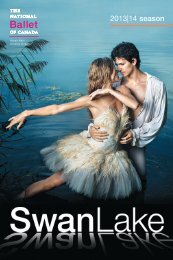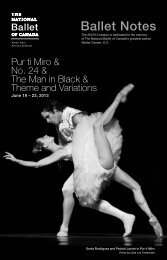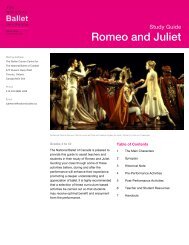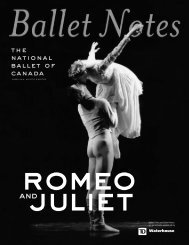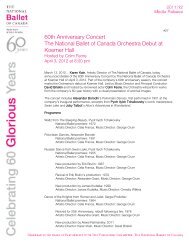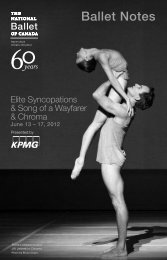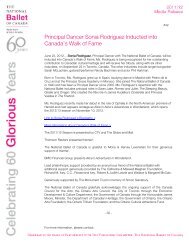intermezzo - The National Ballet of Canada
intermezzo - The National Ballet of Canada
intermezzo - The National Ballet of Canada
You also want an ePaper? Increase the reach of your titles
YUMPU automatically turns print PDFs into web optimized ePapers that Google loves.
<strong>Ballet</strong> Notes<br />
the national ballet <strong>of</strong> canada<br />
karen kain, artistic director<br />
la sylphide<br />
and<br />
<strong>intermezzo</strong><br />
<strong>Ballet</strong> Talks and <strong>Ballet</strong> Notes<br />
are generously sponsored by
marie taglioni in an 1832 production<br />
<strong>of</strong> la sylphide, watercolour by alfrededward<br />
chalon (bridgeman art library).<br />
opposite: guillaume côté, 2004 photo<br />
by bruce zinger<br />
cover: nikolaj hübbe, courtesy <strong>of</strong> the<br />
royal danish ballet<br />
the national ballet <strong>of</strong> canada<br />
<strong>The</strong> Walter Carsen Centre for the national ballet <strong>of</strong> canada<br />
470 Queens Quay West, Toronto, Ontario m5v 3k4 416-345-9686<br />
www.national.ballet.ca
<strong>intermezzo</strong><br />
Choreography by Eliot Feld<br />
Staged with the assistance <strong>of</strong> Christine Sarry<br />
and Timothy Cronin<br />
Music by Johannes Brahms<br />
Intermezzi Opus 117, No. 2 and Opus 118, No. 2; Waltzes Opus 39<br />
Costume Design by Stanley Simmons<br />
Lighting Design by Allen Lee Hughes<br />
Piano Soloist Andrew Burashko<br />
la sylphide<br />
A Romantic <strong>Ballet</strong> in two acts<br />
Choreography by Nikolaj Hübbe<br />
after August Bournonville<br />
Music by Herman Løvenskjold<br />
Set and Costume Design by Peter Cazalet<br />
Lighting Design by Pierre Lavoie<br />
In honour <strong>of</strong> the bicentenary <strong>of</strong> choreographer August Bournonville’s birth,<br />
<strong>The</strong> <strong>National</strong> <strong>Ballet</strong> <strong>of</strong> <strong>Canada</strong> is pleased to present this new production <strong>of</strong><br />
La Sylphide re-staged by Nikolaj Hübbe. New York City <strong>Ballet</strong> Principal Dancer<br />
and Bournonville expert, Mr. Hübbe appears as guest artist in the role <strong>of</strong><br />
James on Thursday, November 24, 2005. <strong>The</strong> production features new sets<br />
and costumes from Boston <strong>Ballet</strong>.<br />
All text in this <strong>Ballet</strong> Note regarding La Sylphide and Bournonville was written by<br />
author and journalist Michael Crabb. Mr. Crabb is dance critic for <strong>The</strong> <strong>National</strong><br />
Post and is heard regularly on CBC Toronto's Here and Now.<br />
<strong>The</strong> <strong>National</strong> <strong>Ballet</strong> <strong>of</strong> <strong>Canada</strong> is honoured to have the esteemed Danish<br />
dance critic Erik Aschengreen as a guest speaker for <strong>Ballet</strong> Talks for the run<br />
<strong>of</strong> La Sylphide. Mr. Aschengreen is one <strong>of</strong> the world’s leading experts on ballet<br />
history and the choreography <strong>of</strong> August Bournonville.<br />
Mr. Aschengreen’s appearance courtesy<br />
<strong>of</strong> the Danish Embassy. additional<br />
support provided by novo nordisk,<br />
and the danish arts agency.
<strong>intermezzo</strong><br />
One <strong>of</strong> Eliot Feld’s earliest works, the evocative, romantic Intermezzo premiered in Spoleto, Italy, on June<br />
29, 1969 performed by Feld’s own American <strong>Ballet</strong> Company. Feld himself danced the lead role, partnering<br />
ballerina Christine Sarry. Two years later, Feld mounted the work on <strong>The</strong> <strong>National</strong> <strong>Ballet</strong> <strong>of</strong><br />
<strong>Canada</strong>, casting a very young Karen Kain and Frank Augustyn, dancing together for the first time, as<br />
one <strong>of</strong> three couples in this lyrical ensemble work. <strong>The</strong> <strong>National</strong> <strong>Ballet</strong> premiered the ballet in Windsor<br />
on February 18, 1972, with Veronica Tennant, Karen Kain, Mary Jago, Sergiu Stefanschi, Jacques<br />
Gorrissen, and Tomas Schramek (replacing the injured Augustyn).<br />
This inventive, highly musical work set to the piano music <strong>of</strong> Johannes Brahms enraptured audiences.<br />
Doris Hering, dance writer for Dance Magazine wrote, “Why, among style studies, does Intermezzo work<br />
with such truth? Precisely because Feld is a romanticist. <strong>The</strong> Brahms intermezzi used as an accompaniment<br />
have obviously stirred him deeply, so deeply that the mood <strong>of</strong> the music permeates the dancers’<br />
bodies even before a single note has been formed beneath the pianist’s fingers…”<br />
Born in Brooklyn, New York, Eliot Feld is regarded as one <strong>of</strong> America’s most original and inventive<br />
ballet choreographers. Feld’s canon <strong>of</strong> work has come to embody a distinctive vision <strong>of</strong> contemporary<br />
American ballet. His ballets are in the repertoire <strong>of</strong> the American <strong>Ballet</strong> <strong>The</strong>atre, American <strong>Ballet</strong><br />
Company, Royal Danish <strong>Ballet</strong>, <strong>The</strong> J<strong>of</strong>frey <strong>Ballet</strong>, John Curry Skating Company, <strong>The</strong> Royal Swedish<br />
<strong>Ballet</strong>, <strong>The</strong> Royal Winnipeg <strong>Ballet</strong>, London Festival <strong>Ballet</strong>, Boston <strong>Ballet</strong>, San Francisco <strong>Ballet</strong>, Atlanta<br />
heather ogden and nehemiah kish, 2002 photo by andrew oxenham stacey shiori minagawa and jillian vanstone, 2003
<strong>Ballet</strong>, Richmond <strong>Ballet</strong>, New York City Opera, New York City <strong>Ballet</strong>, Feld <strong>Ballet</strong>s/NY (now known as<br />
<strong>Ballet</strong> Tech) and <strong>The</strong> <strong>National</strong> <strong>Ballet</strong> <strong>of</strong> <strong>Canada</strong>.<br />
Feld studied dance at the School <strong>of</strong> American <strong>Ballet</strong>, the New Dance Group and the High School <strong>of</strong> the<br />
Performing Arts. At the age <strong>of</strong> 12, he performed the role <strong>of</strong> Child Prince in George Balanchine’s original<br />
production <strong>of</strong> <strong>The</strong> Nutcracker for New York City <strong>Ballet</strong>. At age 16, he joined the Broadway cast <strong>of</strong> West<br />
Side Story and appeared as Baby-John in the movie version. He also performed in the Broadway musicals<br />
I Can Get It For You Wholesale and Fiddler on the Ro<strong>of</strong>. In addition, Feld performed on the Gary Moore and<br />
Ed Sullivan television shows.<br />
Feld <strong>Ballet</strong>s/NY was established in 1974 and the versatile dancers <strong>of</strong> the company are known for their<br />
talent in assisting Feld in the invention <strong>of</strong> a new dance language. Feld <strong>Ballet</strong>s/NY regularly performs in<br />
New York at <strong>The</strong> Joyce <strong>The</strong>ater and also tours extensively throughout America and other countries.<br />
Working with Feld for the first time in 1971, Karen Kain realised, “that if I turned myself over to a<br />
gifted choreographer completely, I would discover qualities in myself that I could never have found<br />
alone.” Kain became a frequent guest artist with his company. <strong>The</strong> <strong>National</strong> <strong>Ballet</strong> <strong>of</strong> <strong>Canada</strong> and Feld<br />
<strong>Ballet</strong>s/NY have maintained a close working relationship, <strong>of</strong>ten collaborating when the <strong>National</strong> <strong>Ballet</strong><br />
performs Feld’s works.<br />
photo by bruce zinger karen kain and tomas schramek, 1972 photo by anthony crickmay
la sylphide<br />
chan hon goh with artists <strong>of</strong> the ballet, 1993 photo by david street karen kain and frank augustyn with artists <strong>of</strong> the ballet, 1974<br />
synopsis<br />
Act I: We are in early 19th century Scotland, in the home <strong>of</strong> James, a young gentleman farmer. James,<br />
who is to marry Effy this very day, slumbers in a wing chair beside the fireplace. <strong>The</strong> Sylph, in love with<br />
James, sits at his feet then awakens him with a kiss. James, unsure if he is merely dreaming, tries to catch<br />
the playful spirit creature but she vanishes up the chimney. When Effy arrives, James is again sitting in<br />
his chair, preoccupied with what has just happened. Effy tries to gain his attention and James leaps up,<br />
expecting it to be the Sylph. He tries to reassure Effy and pr<strong>of</strong>esses his undying love but Gurn, James’<br />
rival for Effy’s hand, is suspicious and believes he may yet have a chance to win her.<br />
As the household busies itself for the wedding it is clear that the brooding James’ thoughts are elsewhere.<br />
He is angered to discover that a dishevelled old woman, Madge, has sneaked in to warm herself by the<br />
fire. Effy intervenes to stop James from forcibly ejecting her. Despite his protests, Madge – suitably<br />
lubricated – is persuaded to read the assembled girls’ fortunes. When Gurn asks her to read his palm<br />
Madge tells him he is destined to marry Effy. <strong>The</strong> enraged James drives Madge from the house.<br />
When James is alone again the Sylph appears at the window and enters to tell him <strong>of</strong> her devotion. James<br />
is initially hesitant but soon enraptured by this vision <strong>of</strong> beauty. Gurn returns to witness James’ extraordinary<br />
behaviour but, when he summons the other guests in order to expose James’ apparent infidelity,<br />
the Sylph has mysteriously vanished. Gurn’s accusation is dismissed. However, as the guests dance James<br />
is again visited by the Sylph. Worried that he may yet marry Effy, she snatches the wedding ring he holds<br />
and runs from the house, with James in hot pursuit. <strong>The</strong> unnoticing guests now turn to salute the bridegroom,<br />
only to discover that he is gone. Gurn runs to see what has happened and returns with news that<br />
James has run wildly <strong>of</strong>f into the woods. <strong>The</strong> heartbroken Effy breaks down in despair.
photo by martha swope aleksandar antonijevic and xiao nan yu, 2005 photo by bruce zinger<br />
Act II: In a dark, dank forest, Madge gathers her fellow witches around a steaming cauldron. <strong>The</strong>y have<br />
concocted an evil brew in which she dips the veil they have woven. <strong>The</strong> witches vanish, the mist clears and<br />
the day brightens to reveal a woodland clearing to which the Sylph has led James. She asks if he loves her,<br />
and James, still uncertain, says he does and the Sylph’s many sisters dance for him. He runs after when<br />
they fly away.<br />
<strong>The</strong> wedding party is still searching for James. Gurn enters to find James’ abandoned cap but before he<br />
can rejoin the others Madge appears, discards the cap and convinces him to propose to Effy. When the<br />
distraught Effy arrives, Gurn convinces her that James has disappeared for good and she reluctantly<br />
accepts his pr<strong>of</strong>fered hand.<br />
James, his heart still torn, returns to the empty glade. When Madge appears she tells James that the magic<br />
veil she holds will enable him to capture the Sylph. James pleads successfully to be given the veil and<br />
Madge leaves. <strong>The</strong> Sylph reappears and James, as instructed by Madge, winds the long veil around her.<br />
He embraces her passionately but immediately senses that something is horribly wrong. <strong>The</strong> Sylph is<br />
dying in his arms and is carried away lifeless by her sisters.<br />
James hides as a wedding party passes through. It is Gurn leading Effy to the altar. Madge, triumphant<br />
in revenge, gloats over James and forces him to watch as the Sylph’s bier floats towards the sky. James,<br />
all hope gone, sinks shattered to the ground.
august bournonville<br />
August Bournonville is one <strong>of</strong> the greatest figures in the history<br />
<strong>of</strong> ballet. His fusion <strong>of</strong> the Italian-influenced traditions <strong>of</strong> the<br />
Royal Danish <strong>Ballet</strong> <strong>of</strong> his early 19th-century childhood with the<br />
style <strong>of</strong> the French pre-Romantic school learned later in Paris<br />
gave rise in Denmark to a unique dancing tradition marked by<br />
grace, musicality, precision, buoyancy and joyfulness. <strong>The</strong> ballets<br />
he created reflect Bournonville’s pr<strong>of</strong>ound confidence in<br />
humanity and espouse values that, while rooted in his own<br />
times, continue to have universal resonance.<br />
As a virtuoso dancer and as a choreographer and teacher<br />
Bournonville also upheld a tradition <strong>of</strong> excellent male dancing<br />
in an age when elsewhere ballerinas reigned supreme. It is no<br />
accident that the Royal Danish <strong>Ballet</strong>, the major repository <strong>of</strong><br />
Bournonville’s surviving works and upholder <strong>of</strong> his teaching,<br />
continues to produce many <strong>of</strong> the world’s finest male dancers.<br />
Through the work <strong>of</strong> Bournonville and his successors the Royal<br />
Danish <strong>Ballet</strong> has achieved a level <strong>of</strong> excellence that is truly<br />
remarkable for so small a country. Former members <strong>of</strong> the<br />
Copenhagen company have and continue to move out into the<br />
wider world <strong>of</strong> ballet as respected dancers,<br />
teachers and artistic directors, bringing with<br />
them a rich Danish heritage passed down<br />
from Bournonville.<br />
Bournonville’s father Antoine, himself an<br />
outstanding dancer and ballet master, was<br />
French. His mother was Swedish. While this<br />
helps account for his thoroughly cosmopolitan<br />
outlook, Bournonville, born in<br />
Copenhagen in 1805, was proudly Danish<br />
and fiercely patriotic. Much as he delighted<br />
in depicting the life and characteristics <strong>of</strong><br />
other European nations in his many ballets –<br />
his 1842 Napoli is the greatest example –<br />
Bournonville felt a special kinship with his<br />
Scandinavian home. He represented its life<br />
and legends in several works, especially A Folk<br />
Tale from 1854, which has almost gained the<br />
stature <strong>of</strong> Denmark’s “national” ballet. His<br />
charmingly sentimental 1860 Far from Denmark reflects<br />
Bournonville’s Danish patriotism in a time <strong>of</strong> international<br />
august bournonville<br />
courtesy <strong>of</strong> the royal danish ballet<br />
strife while also touching, in more down-to-earth and realistic<br />
terms, on the familiar theme <strong>of</strong> man romantically captivated by<br />
the allure <strong>of</strong> an exotic female.<br />
Bournonville’s artistic gifts were many and various. His aptitude<br />
for dance was identified and cultivated from an early age. He<br />
could sing and play the piano. He was an accomplished painter<br />
and became a brilliant writer – sufficient to win the admiration<br />
<strong>of</strong> his friend and fellow Dane, Hans Christian Andersen.<br />
Bournonville’s operatic productions were also widely admired<br />
but it was as a choreographer that he earned his enduring place<br />
as one <strong>of</strong> the greatest figures <strong>of</strong> Denmark’s cultural “Golden<br />
Age.” He was not unaware <strong>of</strong> his own major celebrity and his<br />
personal vanity frequently drew satirical responses from columnists<br />
and cartoonists.<br />
August Bournonville’s ballet training began in earnest when his<br />
father Antoine was appointed <strong>Ballet</strong> Master – effectively Artistic<br />
Director – <strong>of</strong> the Royal Danish <strong>The</strong>atre in 1816. Antoine<br />
Bournonville, a student <strong>of</strong> the great French ballet reformer<br />
Jean-George Noverre, had already begun to shape a distinctively<br />
Danish style <strong>of</strong> dancing. He sought to combine the Italian ballet<br />
mime tradition, so much a part <strong>of</strong> the work <strong>of</strong> his predecessor in<br />
Copenhagen, Vincenzo Galeotti, with the French emphasis on<br />
story-telling through dance. It was Antoine’s son August who<br />
developed and perfected this synthesis in a way that allowed<br />
mime and dance to co-exist in a seamless narrative flow.<br />
August Bournonville first visited Paris in 1820 and studied there<br />
from 1824 to 1826 under the great Auguste Vestris. <strong>The</strong> French<br />
capital made a lasting impression on the young man. Although<br />
he later spent time in most <strong>of</strong> Europe’s major capitals, he<br />
thought <strong>of</strong> Paris almost as a spiritual home.<br />
Bournonville danced with the ballet company <strong>of</strong> the Paris Opera<br />
and toured to London before resettling in Copenhagen in 1830.<br />
Though only in his mid-twenties, he was hired not only as a<br />
dancer but also as <strong>Ballet</strong> Master. With only brief interruptions<br />
it was a post he retained until 1877, long enough to see his<br />
company move from the cramped opera house <strong>of</strong> his youth<br />
into the larger theatre the Royal Danish <strong>Ballet</strong> still occupies.<br />
Bournonville also married in 1830 – he hid<br />
the fact that he had earlier fathered a child<br />
in Paris – and he and his Swedish-born wife<br />
Helene went on to have six children and live<br />
a life <strong>of</strong> exemplary domestic respectability.<br />
<strong>The</strong>ir home, close by one <strong>of</strong> the royal<br />
palaces, was visited by many leading<br />
cultural figures <strong>of</strong> the day.<br />
Bournonville’s La Sylphide from 1836 was<br />
his first ballet to gain lasting acceptance<br />
and internationally remains his best-known<br />
work. Unlike many <strong>of</strong> his other ballets La<br />
Sylphide was not an original. <strong>The</strong> first ballet<br />
adaptation <strong>of</strong> Charles Nodier’s 1822 story<br />
Trilby, ou le lutin d’Argail was produced in 1828<br />
in Milan as La silfide by the French-born<br />
dancer and choreographer Louis-Xavier-<br />
Stanislas Henry. It was Italian Filippo<br />
Taglioni’s 1832 Paris production, however, that took the ballet<br />
world by storm with performances in London and Berlin<br />
and later New York, St. Petersburg and Vienna. Taglioni’s La<br />
Sylphide, with his celebrated daughter Marie in the title role,<br />
in many respects marks the start <strong>of</strong> the French Romantic era<br />
in ballet.<br />
Bournonville was enchanted by La Sylphide when he saw the ballet<br />
in Paris in 1834 and soon decided to stage his own version in<br />
Copenhagen, but his was no mere knock-<strong>of</strong>f.<br />
While largely adhering to the original story <strong>of</strong> a Scottish farmer,<br />
lured from his intended bride by a mischievous woodland spirit<br />
creature, Bournonville, intent on dancing the misguided hero<br />
James, refashioned the ballet in his own style to give the male<br />
lead greater dramatic and choreographic prominence. Also,<br />
more for logistical than artistic reasons, he commissioned a<br />
new score from Norwegian-Danish composer Herman Severin<br />
Løvenskjold. Although there have been other ballet versions <strong>of</strong><br />
the story and a reconstruction <strong>of</strong> Taglioni’s Paris production, it<br />
is Bournonville’s La Sylphide that has gained the widest currency<br />
and survived with its essential elements and style intact.
ournonville and the national ballet: a long tradition<br />
Veteran <strong>National</strong> <strong>Ballet</strong> watchers will never forget New Year’s Eve, 1964. It marked the company premiere <strong>of</strong> August<br />
Bournonville’s 1836 Romantic masterpiece, La Sylphide, staged by Erik Bruhn, one <strong>of</strong> the greatest exponents <strong>of</strong> the<br />
Danish choreographer’s joyful, fleet-footed style.<br />
Bruhn danced the hero James. His Sylph was Canadian-born ballerina Lynn Seymour, by then an established star<br />
<strong>of</strong> Britain’s Royal <strong>Ballet</strong>. This in itself was enough to generate excitement but when word spread that the great Soviet<br />
defector, Rudolf Nureyev, had arrived in Toronto to see his friend Bruhn’s first ballet production, balletomania<br />
reached fever pitch. When Bruhn later developed a troubling injury, <strong>National</strong> <strong>Ballet</strong> leading dancer Earl Kraul was<br />
hastily prepared for the role and danced magnificently. However, what understandably riveted public attention was<br />
news that Nureyev himself would make a double debut on January 5, 1965 – his first James and his first appearance<br />
with the company. Despite slipping on ice and spraining his ankles, the heavily bandaged Nureyev scored a personal<br />
triumph. It was altogether an exciting moment in the <strong>National</strong> <strong>Ballet</strong>’s early history.<br />
<strong>The</strong> decision to stage La Sylphide was a bold initiative on the part <strong>of</strong> Celia Franca, the <strong>National</strong> <strong>Ballet</strong>’s founding<br />
Artistic Director and at Bruhn’s insistence its first Madge, the evil witch who seals James’ fate.<br />
When the decision was made, the <strong>National</strong> <strong>Ballet</strong> was the first North American company to commit to staging La<br />
Sylphide although Lucia Chase’s American <strong>Ballet</strong> <strong>The</strong>atre – could Chase have got wind <strong>of</strong> Franca’s plans? – unveiled<br />
a production <strong>of</strong> its own just weeks before the <strong>National</strong> <strong>Ballet</strong>’s.<br />
Although dancers, particularly male dancers trained in the Royal Danish <strong>Ballet</strong>’s Bournonville tradition, were gaining<br />
international prominence – Bruhn was a prime example – outside his homeland Bournonville’s choreography<br />
was unfamiliar to audiences <strong>of</strong> the mid-1960s. As leading Bournonville expert Erik Aschengreen explains, it was<br />
not until the international media descended on Copenhagen for the first Bournonville Festival in 1979 that the<br />
great choreographer truly achieved a “posthumous international breakthrough”.<br />
So Franca was taking a risk, albeit a shrewdly calculated one. She was motivated by her eagerness to build a distinctive<br />
repertoire for the <strong>National</strong> <strong>Ballet</strong> and by an awareness <strong>of</strong> the salutary challenge Bournonville’s stylistically and<br />
technically difficult choreography would <strong>of</strong>fer her dancers.<br />
According to Franca, it was her friendship with Erik Bruhn that was the deciding factor. Franca had invited Bruhn,<br />
then still a young member <strong>of</strong> the Royal Danish <strong>Ballet</strong>, to dance as a guest in London with the short-lived<br />
erik bruhn and lynn seymour with artists <strong>of</strong> the ballet, 1964 rudolf nureyev with artists <strong>of</strong> the ballet, 1973 photo by jones & morris
Metropolitan <strong>Ballet</strong>. <strong>The</strong> two stayed in touch and, as she considered the possibility <strong>of</strong> presenting La Sylphide Franca<br />
travelled to Copenhagen to see it. After watching Bruhn deliver a superb performance as James, Franca visited his<br />
dressing room and, knowing Bruhn’s interest in staging a production, invited him to do so in <strong>Canada</strong>. Franca and<br />
her then husband spent hours first acquiring and then pouring over the lengthy Løvenskjold score to edit it appropriately<br />
for Bruhn’s intentions. “It was a lot <strong>of</strong> work,” Franca still recalls.<br />
It was the start <strong>of</strong> a unique connection between the <strong>National</strong> <strong>Ballet</strong> and Denmark’s Bournonville tradition that, with<br />
the unveiling <strong>of</strong> a new production <strong>of</strong> La Sylphide, continues to this day. <strong>The</strong> connection has many dimensions and<br />
vividly illustrates the bonds that art has the power to build between nations.<br />
Bruhn’s association with the <strong>National</strong> <strong>Ballet</strong> continued and blossomed during the ensuing 22 years, culminating in<br />
his Artistic Directorship, 1983-86. His production <strong>of</strong> La Sylphide became a much-loved staple <strong>of</strong> the repertoire and<br />
a wonderful vehicle for its leading dancers. Bruhn himself continued to appear in it, latterly and memorably as the<br />
malevolent Madge.<br />
Bruhn also began to teach at the <strong>National</strong> <strong>Ballet</strong> School and formed a valuable friendship with its founding<br />
principal, Betty Oliphant. Through his teaching as well as his dancing example, Bruhn helped inculcate a Canadian<br />
facility in the difficult Bournonville style which while appropriately accented – perhaps a little bolder and larger<br />
than the Danes – still had the mark <strong>of</strong> authenticity.<br />
<strong>Canada</strong>’s <strong>National</strong> <strong>Ballet</strong> School’s connection to the Bournonville tradition and Royal Danish <strong>Ballet</strong> School survived<br />
Bruhn’s sadly premature death in 1986. Student and teacher exchanges still continue and, following in Bruhn’s<br />
footsteps, several distinguished members and former members <strong>of</strong> the Royal Danish <strong>Ballet</strong> – including Peter<br />
Martins, Peter Schaufuss and Johan Kobborg – have danced with the company.<br />
<strong>The</strong> <strong>National</strong> <strong>Ballet</strong>’s expertise in the exacting Bournonville style was an important factor in Alexander Grant’s<br />
decision as Artistic Director, 1976-83, to stage North America’s first full-length production <strong>of</strong> Bournonville’s<br />
exuberantly enchanting three-act Napoli. As Franca had turned to Bruhn, so Grant turned to Peter Schaufuss.<br />
Schaufuss, son <strong>of</strong> the celebrated Danish dancers Frank Schaufuss and Mona Vangsaae, had been present as a<br />
teenager for the 1964 premiere <strong>of</strong> Bruhn’s La Sylphide because that same season his father was appearing as a guest<br />
artist in Franca’s <strong>The</strong> Nutcracker. Schaufuss danced with the <strong>National</strong> <strong>Ballet</strong> from 1967 to 1969, went on to achieve<br />
fame with New York City <strong>Ballet</strong>, and returned to Toronto under Grant in 1977. Grant confronted a good deal <strong>of</strong><br />
skepticism in the run-up to Napoli but its Toronto premiere in 1981 was an international triumph and reinforced<br />
the company’s link with Bournonville. Soon afterwards, it was a performance <strong>of</strong> Napoli that was chosen to mark the<br />
celia franca, 1965 photo by ken bell lois smith and earl kraul, 1965 photo by ken bell peter schaufuss, 1981 photo by andrew oxenham
<strong>National</strong> <strong>Ballet</strong>’s 30th anniversary. And what a performance, uniting Danes and Canadians in a rapturous celebration!<br />
Schaufuss partnered Veronica Tennant in the leading romantic roles, Grant joined Bruhn and another great<br />
Danish dancer, Neils Bjørn Larsen, to perform the three major male character parts and former <strong>National</strong> <strong>Ballet</strong><br />
stars Yves Cousineau and Lois Smith performed supporting roles. Grant had even convinced Franca to take on<br />
what is normally a supernumerary role. Needless to say, in her character’s elegant black widow’s weeds, Franca<br />
momentarily stole the show. <strong>The</strong>n, in Act III, there were the children from the <strong>National</strong> <strong>Ballet</strong> School – the next<br />
generation – up on the bridge waving their flags and banging their tambourines while all the company’s senior<br />
ballerinas danced below.<br />
Although the complete Napoli has not been seen since 1991, Nikolaj Hübbe staged the brilliant divertissements from<br />
Act III in 2003. In between, under Artistic Director James Kudelka, the <strong>National</strong> <strong>Ballet</strong> presented a reconstruction<br />
<strong>of</strong> Bournonville’s full length Tales <strong>of</strong> the Arabian Nights: <strong>The</strong> Story <strong>of</strong> Abdallah in 1997.<br />
<strong>The</strong> Erik Bruhn Prize, an occasional invitational competition established through a bequest from the late great<br />
dancer, is another important link. Bruhn wanted a celebration <strong>of</strong> young talent drawn from companies with whom<br />
he had felt a strong allegiance during his distinguished career. Naturally the <strong>National</strong> <strong>Ballet</strong> and the Royal Danish<br />
<strong>Ballet</strong> were two <strong>of</strong> them. As a result, Canadian audiences have a continuing opportunity to enjoy and admire<br />
emerging talents from both companies. Several <strong>of</strong> the leading lights <strong>of</strong> today’s Royal Danish <strong>Ballet</strong> performed here<br />
as young dancers because <strong>of</strong> Bruhn’s foresighted legacy.<br />
So, the tradition continues and perhaps for reasons that reach deeper than fortuitous pr<strong>of</strong>essional friendships and<br />
the desire <strong>of</strong> successive Artistic Directors to <strong>of</strong>fer audiences something attractively distinctive.<br />
<strong>The</strong> values inherent in the Bournonville style and in his greatest ballets are modest, humane and civilized.<br />
Although, as in La Sylphide, Bournonville embraced 19th-century ballet’s fascination with tales <strong>of</strong> the supernatural –<br />
a fundamental component <strong>of</strong> art in the Romantic Era – his true allegiance was grounded in a wholesome reality<br />
where good triumphs over evil and ordinary people live in tolerant harmony with each other. <strong>The</strong>y learn<br />
to accommodate and to resist extreme reactions and dangerous temptations. Note how the sad fate <strong>of</strong> James in<br />
La Sylphide is instructively contrasted with the ultimately happy union <strong>of</strong> Effy and her stalwart admirer, Gurn.<br />
<strong>The</strong>n, in the dancing, there is a naturalness and buoyancy that despite its technical complexity has nothing to<br />
do with showing <strong>of</strong>f. <strong>The</strong> choreography is approachable, generous spirited and life affirming. Is it too much to<br />
suggest that this explains why <strong>Canada</strong> in particular has forged such a special bond with this Danish master <strong>of</strong> the<br />
art <strong>of</strong> ballet and with the company he led to greatness?<br />
mikhail baryshnikov, 1974 photo by martha swope nikolaj hübbe with artists <strong>of</strong> the ballet rehearsing la sylphide, 2005 photo by bruce zinger



